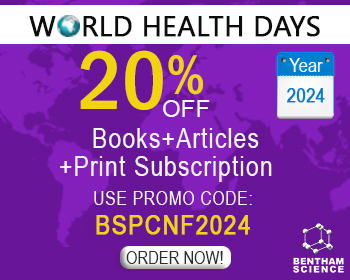Abstract
Undoubtedly, antibiotics have saved billions of lives, but lack of novel antibiotics, development of resistance mechanisms in almost all clinical isolates of bacteria, and recurrent infections caused by persistent bacteria hamper the successful treatment of the infections. Due to the widespread emergence of resistance, even the new families of anti-microbial agents have a short life expectancy. Drugs acting on a single target often lead to drug resistance and are associated with various side effects. For overcoming this problem, either multidrug therapy, or a single drug acting on multiple targets may be used. The latter is called ‘hybrid molecules,’ which are formed by clubbing two biologically active pharmacophores together, with or without an appropriate linker. In this rapidly evolving era, the development of natural product-based hybrid molecules may be a super-alternative to multidrug therapy, for combating drug resistance caused by various bacterial and fungal strains. Coumarins (benzopyran-2-one) are one of the earliest reported plant secondary metabolites having a clinically proven diverse range of pharmacological properties. On the other hand, 1,2,3-triazole is a common pharmacophore in many drugs responsible for polar interactions, improving the solubility and binding affinity to biomolecular targets. In this review, we discuss recent advances in Coumarin-1,2,3-triazole hybrids as potential anti-bacterial agents, aiming to provide a useful platform for the exploration of new leads with a broader spectrum, more effectiveness and less toxicity with multiple modes of action for the development of cost-effective and safer drugs in the future.
Keywords: Drug-resistance, Coumarin, 1, 2, 3-Triazole, Hybrid molecules, Antibacterial, Antitubercular.
[http://dx.doi.org/10.2174/1875692116666180419153313]
[http://dx.doi.org/10.1021/np9604893] [PMID: 9014353]
[http://dx.doi.org/10.3390/molecules21050559] [PMID: 27136524]
[PMID: 21554174]
[http://dx.doi.org/10.1007/s11606-008-0632-y] [PMID: 18415652]
[http://dx.doi.org/10.3389/fphar.2019.01480] [PMID: 31998121]
[http://dx.doi.org/10.1016/B978-0-12-802104-0.00002-0]
[http://dx.doi.org/10.1201/9780203719473]
[http://dx.doi.org/10.1089/acm.2012.0275] [PMID: 23829812]
[http://dx.doi.org/10.1016/j.jtcme.2016.05.006] [PMID: 28417092]
[http://dx.doi.org/10.1016/j.amjmed.2003.10.036] [PMID: 15047038]
[http://dx.doi.org/10.2174/138161210793176464] [PMID: 20858178]
[http://dx.doi.org/10.4314/ajtcam.v4i3.31226] [PMID: 20161896]
[http://dx.doi.org/10.1080/14786419.2017.1356838] [PMID: 28748726]
[http://dx.doi.org/10.1007/BF03020955] [PMID: 10764185]
[http://dx.doi.org/10.4103/0019-5049.193696] [PMID: 27942064]
[http://dx.doi.org/10.11622/smedj.2015105] [PMID: 26243971]
[http://dx.doi.org/10.1007/s00253-011-3587-6] [PMID: 21964640]
[http://dx.doi.org/10.3390/ijms19061578] [PMID: 29799486]
[http://dx.doi.org/10.1016/j.bcp.2005.10.012] [PMID: 16289393]
[http://dx.doi.org/10.1111/j.1465-0691.2004.1007.x] [PMID: 15522037]
[http://dx.doi.org/10.1038/nrd940] [PMID: 12415249]
[http://dx.doi.org/10.1016/j.lfs.2005.09.012] [PMID: 16198377]
[http://dx.doi.org/10.2174/1568026619666190412101047] [PMID: 30977452]
[http://dx.doi.org/10.2174/157018011795514249]
[http://dx.doi.org/10.1016/j.ejps.2012.05.009] [PMID: 22659375]
[http://dx.doi.org/10.1093/chromsci/bms099] [PMID: 22700790]
[http://dx.doi.org/10.2174/0929867325666180501102450] [PMID: 29714138]
[http://dx.doi.org/10.2174/1568026619666190412120008] [PMID: 30977451]
[http://dx.doi.org/10.1177/1934578X1200700724] [PMID: 22908576]
[http://dx.doi.org/10.1111/cbdd.12263] [PMID: 24267788]
[http://dx.doi.org/10.1002/cmdc.201402027] [PMID: 24891085]
[http://dx.doi.org/10.1007/s00044-017-2132-2]
[http://dx.doi.org/10.2174/157019312800604706]
[http://dx.doi.org/10.1007/s00894-011-1327-6] [PMID: 22271093]
[http://dx.doi.org/10.2174/09298673113206660330] [PMID: 24180274]
[http://dx.doi.org/10.1021/np030096l] [PMID: 12880330]
[http://dx.doi.org/10.1021/np200906s] [PMID: 22316239]
[http://dx.doi.org/10.3390/metabo2020303] [PMID: 24957513]
[http://dx.doi.org/10.2174/0929867043365116] [PMID: 15180572]
[http://dx.doi.org/10.2174/0929867326666190618113613]
[http://dx.doi.org/10.2174/0929867324666170523120656] [PMID: 28545378]
[http://dx.doi.org/10.1517/17460441.3.5.487] [PMID: 23484922]
[http://dx.doi.org/10.1016/j.cell.2007.03.004] [PMID: 17382878]
[http://dx.doi.org/10.1016/S1473-3099(13)70318-9] [PMID: 24252483]
[http://dx.doi.org/10.7759/cureus.1403] [PMID: 28852600]
[http://dx.doi.org/10.1073/pnas.1717295115] [PMID: 29581252]
[http://dx.doi.org/10.1128/microbiolspec.VMBF-0016-2015] [PMID: 27227291]
[http://dx.doi.org/10.1111/1751-7915.13587] [PMID: 32483942]
[http://dx.doi.org/10.1126/science.aal0829]
[http://dx.doi.org/10.1080/03009734.2016.1195900] [PMID: 27416324]
[http://dx.doi.org/10.1371/journal.pmed.1002184] [PMID: 27898664]
[http://dx.doi.org/10.1038/ja.2017.124] [PMID: 29089600]
[http://dx.doi.org/10.4137/PMC.S14459] [PMID: 25232278]
[http://dx.doi.org/10.1016/j.mib.2017.10.028] [PMID: 29154024]
[http://dx.doi.org/10.2337/dc11-s235] [PMID: 21525461]
[PMID: 18078018]
[http://dx.doi.org/10.1016/j.ejmech.2014.03.018] [PMID: 24685980]
[http://dx.doi.org/10.1021/jm058225d]
[http://dx.doi.org/10.2174/9781681080765115040008]
[http://dx.doi.org/10.2174/1381612821666150506154434] [PMID: 25961308]
[http://dx.doi.org/10.4103/0972-5229.132495] [PMID: 24914260]
[http://dx.doi.org/10.1128/CMR.05041-11] [PMID: 22763634]
[http://dx.doi.org/10.1016/j.ejmech.2016.08.039] [PMID: 27598238]
[http://dx.doi.org/10.1021/ar7000843] [PMID: 17665872]
[http://dx.doi.org/10.1517/17460441.2010.508069] [PMID: 22823262]
[http://dx.doi.org/10.1080/17460441.2016.1187597] [PMID: 27169483]
[http://dx.doi.org/10.1517/17460441.2016.1135125] [PMID: 26727036]
[http://dx.doi.org/10.1016/j.ejmech.2018.03.057] [PMID: 29605809]
[http://dx.doi.org/10.2174/092986711795328355] [PMID: 21428895]
[http://dx.doi.org/10.1002/anie.200200553] [PMID: 12973759]
[http://dx.doi.org/10.1111/cbdd.12629] [PMID: 26242562]
[http://dx.doi.org/10.1080/07352689.2011.616039]
[http://dx.doi.org/10.3923/rjphyto.2011.170.176]
[http://dx.doi.org/10.1055/s-0031-1280256] [PMID: 21969115]
[PMID: 22876957]
[http://dx.doi.org/10.1177/1934578X1300801123] [PMID: 24427949]
[http://dx.doi.org/10.1016/j.bmc.2011.12.042] [PMID: 22257528]
[http://dx.doi.org/10.2174/1568026615666150427125916] [PMID: 25915605]
[http://dx.doi.org/10.1177/1934578X0900401219] [PMID: 20120111]
[http://dx.doi.org/10.1016/j.phymed.2014.06.017] [PMID: 25172794]
[http://dx.doi.org/10.1007/s00044-013-0682-5]
[http://dx.doi.org/10.3109/13880209.2013.790453] [PMID: 23767769]
[http://dx.doi.org/10.1016/j.apjtm.2016.01.014] [PMID: 26919937]
[http://dx.doi.org/10.2174/1568026618666180329115523] [PMID: 29595110]
[http://dx.doi.org/10.1007/s00044-012-9998-9]
[http://dx.doi.org/10.5530/srp.2017.1.4]
[http://dx.doi.org/10.1021/jm00078a001] [PMID: 7506311]
[http://dx.doi.org/10.1016/S0960-894X(98)00628-3] [PMID: 9934455]
[http://dx.doi.org/10.1038/emm.2005.54] [PMID: 16264268]
[http://dx.doi.org/10.1248/bpb.33.1610] [PMID: 20823583]
[http://dx.doi.org/10.1016/S0944-7113(00)80075-6] [PMID: 10715850]
[PMID: 1222119]
[http://dx.doi.org/10.1111/j.1747-0285.2011.01173.x] [PMID: 21736704]
[PMID: 20856844]
[http://dx.doi.org/10.2174/1389557516666160801094919] [PMID: 27488585]
[http://dx.doi.org/10.1016/j.ejmech.2015.07.010] [PMID: 26188907]
[http://dx.doi.org/10.2174/1568026618666180221114515] [PMID: 29473509]
[http://dx.doi.org/10.1016/j.ejmech.2017.06.051] [PMID: 28692915]
[http://dx.doi.org/10.1016/j.bmc.2006.08.019] [PMID: 16949290]
[http://dx.doi.org/10.1016/j.bioorg.2017.01.010] [PMID: 28126288]
[http://dx.doi.org/10.1016/j.ejmech.2019.02.055] [PMID: 30826511]
[http://dx.doi.org/10.1007/s11030-011-9319-0] [PMID: 21633789]
[http://dx.doi.org/10.2174/1389557519666190312162601] [PMID: 30864516]
[http://dx.doi.org/10.2174/092986712803414213] [PMID: 22320301]
[http://dx.doi.org/10.2165/00003495-198020020-00007] [PMID: 6995096]
[http://dx.doi.org/10.1111/j.1528-1167.2008.01665.x] [PMID: 18503564]
[PMID: 8818579]
[http://dx.doi.org/10.1016/j.ejmech.2019.111587] [PMID: 31404864]
[http://dx.doi.org/10.1016/j.bmc.2014.05.032] [PMID: 24934993]
[http://dx.doi.org/10.1002/ardp.201900380] [PMID: 32253782]
[http://dx.doi.org/10.1016/j.ejmech.2015.08.033] [PMID: 26318068]
[http://dx.doi.org/10.2174/1389557519666190308122509] [PMID: 30854961]
[http://dx.doi.org/10.1016/S0065-7743(08)00017-1]
[http://dx.doi.org/10.1016/j.coph.2008.06.008] [PMID: 18621146]
[http://dx.doi.org/10.1070/RCR4448]
[http://dx.doi.org/10.3390/ijms19041104] [PMID: 29642417]
[PMID: 21399701]
[http://dx.doi.org/10.1016/j.bmc.2016.12.019] [PMID: 28038941]
[http://dx.doi.org/10.1016/j.bmc.2019.06.033] [PMID: 31255497]
[http://dx.doi.org/10.1016/j.bmcl.2017.07.069] [PMID: 28797799]
[http://dx.doi.org/10.1039/C6RA07071J]
[http://dx.doi.org/10.1016/j.ejmech.2016.03.087] [PMID: 27155469]
[PMID: 29243577]
[http://dx.doi.org/10.1111/cbdd.13316] [PMID: 29679445]
[http://dx.doi.org/10.1080/00397911.2020.1743318]
[http://dx.doi.org/10.1002/slct.201904783] [PMID: 32328514]
[http://dx.doi.org/10.1016/j.bioorg.2016.08.005] [PMID: 27544072]
[http://dx.doi.org/10.1016/j.drudis.2017.05.014] [PMID: 28676407]
[http://dx.doi.org/10.3109/14756360903524304] [PMID: 20583859]
[http://dx.doi.org/10.1517/14656566.2015.1057500] [PMID: 26100603]
[http://dx.doi.org/10.1002/asia.201100432] [PMID: 21954075]
[http://dx.doi.org/10.1002/chin.200528145]
[http://dx.doi.org/10.1016/j.bmcl.2014.02.027] [PMID: 24594353]
[http://dx.doi.org/10.1515/hc-2014-0102]
[http://dx.doi.org/10.1007/s00044-016-1519-9]
[http://dx.doi.org/10.1016/j.ejmech.2016.08.062] [PMID: 27639370]
[http://dx.doi.org/10.1007/s11426-015-0351-0]
[http://dx.doi.org/10.3109/14756366.2016.1158171] [PMID: 27033638]
[http://dx.doi.org/10.1007/s00044-016-1549-3]
[http://dx.doi.org/10.1007/s12039-016-1214-x]
[http://dx.doi.org/10.3390/molecules23010199] [PMID: 29346325]
[http://dx.doi.org/10.1002/jhet.3175]
[PMID: 29243578]
[http://dx.doi.org/10.1016/j.cdc.2018.09.005]
[http://dx.doi.org/10.3390/molecules24112126] [PMID: 31195697]
[http://dx.doi.org/10.1021/acsomega.8b02481] [PMID: 31459961]
[http://dx.doi.org/10.1007/s12039-020-1748-9]
[http://dx.doi.org/10.1039/D0RA01052A]
[http://dx.doi.org/10.1111/j.1747-0285.2012.01441.x] [PMID: 22737986]
[http://dx.doi.org/10.1016/j.ejmech.2015.10.019] [PMID: 26491982]
[http://dx.doi.org/10.1002/ardp.201900013] [PMID: 31397503]
[http://dx.doi.org/10.1016/j.bmc.2019.115054] [PMID: 31471101]
[http://dx.doi.org/10.1016/j.bmcl.2016.08.045] [PMID: 27595420]



























